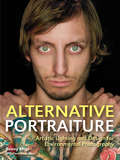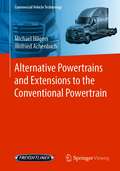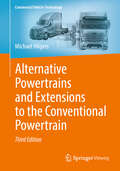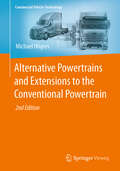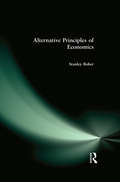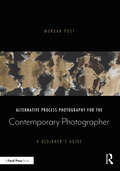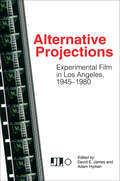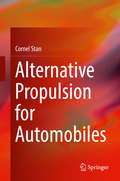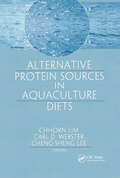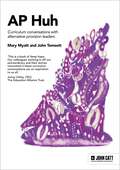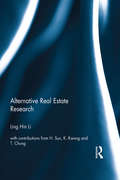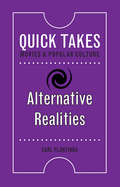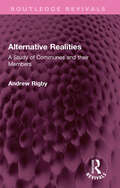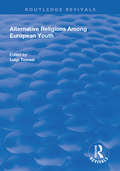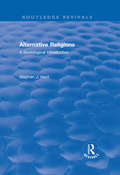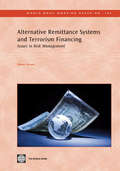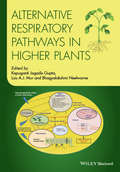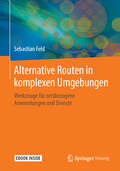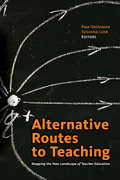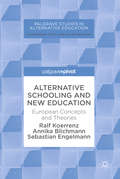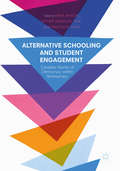- Table View
- List View
Alternative Portraiture
by Benny MigsIn this book, Benny Migliorino teaches readers how to work with speedlights-lightweight, relatively inexpensive, and powerful palm-sized flash units-to create dramatic, dimensional, flattering lighting. 'Migs' presents 60 portraits shot in a wide range of environments-from cramped quarters and fluorescent light, to dimly lit rooms, to makeshift "studio" spaces in a client's home or office. Readers will learn critical lighting skills from reducing the contrast range and creating softer, more flattering light; to re-creating traditional studio lighting patterns in varied existing-light scenarios; to adding fill for a rounder, more dimensional view of the subject; to overpowering the existing light; and working in mixed-light scenarios. Whether you're working solo or with an assistant, with one speedlight or multiple units, using "bare" (unmodified) small flash or harnessing its power via flash-mounted or freestanding light modification devices, you will learn how to make quick work of creating professional, evocative portraits that bring out the best version of your subject and highlight the personal connection he or she has to their personal environment.
Alternative Powertrains and Extensions to the Conventional Powertrain (Commercial Vehicle Technology)
by Michael Hilgers Wilfried AchenbachThe aim of this work, consisting of 9 individual, self-contained booklets, is to describe commercial vehicle technology in a way that is clear, concise and illustrative. Compact and easy to understand, it provides an overview of the technology that goes into modern commercial vehicles. Starting from the customer's fundamental requirements, the characteristics and systems that define the design of the vehicles are presented knowledgeably in a series of articles, each of which can be read and studied on their own. This volume, "Alternative Powertrains and Supplements to the Conventional Powertrain", introduces alternatives and additions to the conventional powertrain of the commercial vehicle. The wide range of options is presented so as to be clearly understandable for those learning and working with them in a practical environment. Hybrid vehicles, electric powertrains and alternative fuels are discussed.
Alternative Powertrains and Extensions to the Conventional Powertrain (Commercial Vehicle Technology)
by Michael HilgersThe aim of this work, consisting of 9 individual, self-contained booklets, is to describe commercial vehicle technology in a way that is clear, concise and illustrative. Compact and easy to understand, it provides an overview of the technology that goes into modern commercial vehicles. Starting from the customer's fundamental requirements, the characteristics and systems that define the design of the vehicles are presented knowledgeably in a series of articles, each of which can be read and studied on their own. This volume, "Alternative Powertrains and Supplements to the Conventional Powertrain", introduces alternatives and additions to the conventional powertrain of the commercial vehicle. The wide range of options is presented so as to be clearly understandable for those learning and working with them in a practical environment. Hybrid vehicles, electric powertrains and alternative fuels are discussed.
Alternative Powertrains and Extensions to the Conventional Powertrain (Commercial Vehicle Technology)
by Michael HilgersThe aim of this work, consisting of 9 individual, self-contained booklets, is to describe commercial vehicle technology in a way that is clear, concise and illustrative. Compact and easy to understand, it provides an overview of the technology that goes into modern commercial vehicles. Starting from the customer's fundamental requirements, the characteristics and systems that define the design of the vehicles are presented knowledgeably in a series of articles, each of which can be read and studied on their own. This volume, "Alternative Powertrains and Supplements to the Conventional Powertrain", introduces alternatives and additions to the conventional powertrain of the commercial vehicle. The wide range of options is presented so as to be clearly understandable for those learning and working with them in a practical environment. Hybrid vehicles, electric powertrains and alternative fuels are discussed.
Alternative Principles of Economics
by Stanley BoberThis is the first book to provide a complete introduction to Post-Keynesian and other alternative theories of economics. Concise yet comprehensive, and written to be accessible to a wide audience, it offers a unique opportunity to enhance traditional neo-classical economics training with authoritative coverage of the full range of the non-orthodox paradigm.
Alternative Process Photography for the Contemporary Photographer: A Beginner's Guide
by Morgan PostA comprehensive textbook, Alternative Process Photography for the Contemporary Photographer explores the ways in which the materiality and science of photography and aesthetic concepts of contemporary photography can work together in an accessible way. The book explores processes such as calotype, wet plate collodion, cyanotype, platinum and palladium, gum bichromate and digital. It explains not only the historical context behind these processes but draws on examples from contemporary practitioners to show how the processes can be used within the field of contemporary photography. Author Morgan Post exemplifies the creative ways in which a contemporary photographer can engage with alternative process photography as a beginner and includes contributions from Takashi Arai, Alida Rodrigues, Binh Danh, Diana H. Bloomfield and many others from around the world. The textbook is accompanied by a companion website offering accessible step-by-step video instructions that demonstrate the processes explored. Bridging analogue and digital media, the textbook is ideal for students of photography and amateur photographers with an interest in alternative methods to photography.
Alternative Projections: Experimental Film In Los Angeles, 1945-1980
by David E. James Adam HymanAlternative Projections: Experimental Film in Los Angeles, 1945-1980 is a groundbreaking anthology that features papers from a conference and series of film screenings on postwar avant-garde filmmaking in Los Angeles sponsored by Filmforum, the Getty Foundation, and the University of Southern California's School of Cinematic Arts, together with newly-commissioned essays, an account of the screening series, reprints of historical documents by and about experimental filmmakers in the region, and other rare photographs and ephemera. The resulting diverse and multi-voiced collection is of great importance, not simply for its relevance to Los Angeles, but also for its general discoveries and projections about alternative cinemas.
Alternative Propulsion for Automobiles
by Cornel StanThe book presents - based on the most recent research and development results worldwide - the perspectives of new propulsion concepts such as electric cars with batteries and fuel cells, and furthermore plug in hybrids with conventional and alternative fuels. The propulsion concepts are evaluated based on specific power, torque characteristic, acceleration behaviour, specific fuel consumption and pollutant emissions. The alternative fuels are discussed in terms of availability, production, technical complexity of the storage on board, costs, safety and infrastructure. The book presents summarized data about vehicles with electric and hybrid propulsion. The propulsion of future cars will be marked by diversity - from compact electric city cars and range extender vehicles for suburban and rural areas up to hybrid or plug in SUV´s, Pick up´s and luxury class automobiles.
Alternative Protein Sources in Aquaculture Diets
by Cheng-Sheng Lee Chhorn Lim Carl D. WebsterA unique resource that describes the ingredients included in an aquaculture diet, species profiles, processing methods, impacts to environment and industry, and more. Aquaculture is and will remain a major food producing sector in the future. To become more efficient and successful in the aquaculture industry, operations need to provide good nutrition. Alternative Protein Sources in Aquaculture Diets is a unique source describing the ingredients included in fish and crustacean diets, their nutrient compositions, species profiles, suitability for species, processing methods, and impacts of alternative ingredients on the environment and to the aquaculture industry. World-renowned nutritionists and feed technologists explore practical ways for the aquaculture industry to expand and remain competitive, and discuss ways to develop less expensive alternative sources or protein. Diet costs take up a huge chunk of operating expenditures, with fish meal being one of the most expensive ingredients in the aquaculture diet. Alternative Protein Sources in Aquaculture Diets provides detailed knowledge on the use of alternative plant and animal protein sources, offering opportunities to either partially or completely replace fish meal. This comprehensive, up-to-date text discusses the most widely used ingredients as well as various previously under-utilized ingredients which could be of significant potential in the future. The book is extensively referenced and includes numerous helpful tables to clearly present data. Topics discussed in Alternative Protein Sources in Aquaculture Diets (for finfish and crustacean species) include: • farmed fish diet requirements • reduction of waste through diet formulation • poultry by-product meal • meat packing by-products • soybean protein foodstuffs • cottonseed meal • lupins • unconventional plant protein supplements.
Alternative Protein Sources: Balancing Food Innovation, Sustainability, Nutrition, And Health: Proceedings Of A Workshop
by Food Forum Food and Nutrition Board National Academies of Sciences, Engineering, and Medicine Health and Medicine DivisionAlternative protein sources, which can be derived from plant and animal cells or created by precision fermentation, can have health, environmental, socio-economic, and ethical impacts. With a variety of types of alternative proteins being developed and available on the market, consumers, regulatory agencies, manufacturers, and researchers are faced with many different considerations. The National Academies Food Forum hosted a workshop that took a multi-sector approach to explore the state of the science on alternative protein sources as they relate to issues around diet quality, nutrition, and sustainability. The workshop also examined how alternative protein food processing innovations can be balanced in a way that optimizes nutritional content, affordability, and accessibility. This Proceedings of a Workshop summarizes the discussions held during the workshop.
Alternative Proteins: Safety and Food Security Considerations
by Alaa El-Din A. BekhitIn the last decade, there has been substantial research dedicated towards prospecting physiochemical, nutritional and health properties of novel protein sources. In addition to being driven by predictions of increased population and lack of a parallel increase in traditional protein sources, main drivers for the rise in novel proteins/ novel foods research activities is linked to significant changes in young consumers’ attitudes toward red meat consumption and their interest in new alternative protein products. Alternative Proteins: Safety and Food Security Considerations presents up-to-date information on alternative proteins from non-meat sources and examines their nutritional and functional roles as food sources and ingredients. Emphasis is placed on the safety of these novel proteins and an evaluation of their potential contribution to food security. Motivations for novel proteins and restrictions for their use are also discussed. Key Features: Explains potential improvements to alternative proteins through the employment of novel processing techniques. Contains the first review on keratin as an alternative protein source. Explores first comprehensive evaluation of the religious aspects of novel proteins. Describes methods for the detection and evaluation of health hazards. Discusses guidelines, regulatory issues and recommendations for food safety Additionally, this book covers fundamental and recent developments in the production of alternative proteins, and examines safety and consumer acceptability wherever information is available. The sources and processing options for alternative proteins and their impact on final product characteristics are also covered. A collective contribution from international researchers who are active in their field of research and have made significant contributions to the the food sciences, this book is beneficial to any researcher interested in the the food science and safety of alternative proteins.
Alternative Provision Huh
by John Tomsett Mary MyattFor one reason or another, mainstream education does not suit every young person. Many young people are educated in alternative provision, which is defined by the Department for Education as educational provision 'for pupils who, because of exclusion, illness or other reasons, would not otherwise receive suitable education'. As of 2023, over 25,000 young people are enrolled in alternative provision, and those numbers continue to rise.It is essential, then, that the curriculum on offer in alternative provision is exemplary, as these young people - already facing extraordinary challenges - need the very best if they are going to progress successfully into adulthood.Huh is the Egyptian god of endlessness, creativity, fertility and regeneration. He is the deity Mary Myatt and John Tomsett have adopted as their god of the curriculum. Their Huh series of books focuses on how practitioners design the curriculum for the young people in their schools.The Huh project is founded on conversations with colleagues doing great work across the education sector. In AP Huh, Mary Myatt and John Tomsett discuss curriculum provision for pupils attending alternative provision with some of the leading experts in the field. Mary and John interviewed pupils, parents, teachers, headteachers, CEOs, educational consultants and lecturers. They then edited the transcriptions of those interviews to provide an ambitious, thoughtful, nuanced and challenging vision of what the best possible provision looks like for children who find that mainstream schooling is not for them.The challenging conversations that comprise AP Huh paint a positive picture that is hugely hopeful for the future of the curriculum in our alternative provision settings.
Alternative Provision Huh
by John Tomsett Mary MyattFor one reason or another, mainstream education does not suit every young person. Many young people are educated in alternative provision, which is defined by the Department for Education as educational provision 'for pupils who, because of exclusion, illness or other reasons, would not otherwise receive suitable education'. As of 2023, over 25,000 young people are enrolled in alternative provision, and those numbers continue to rise.It is essential, then, that the curriculum on offer in alternative provision is exemplary, as these young people - already facing extraordinary challenges - need the very best if they are going to progress successfully into adulthood.Huh is the Egyptian god of endlessness, creativity, fertility and regeneration. He is the deity Mary Myatt and John Tomsett have adopted as their god of the curriculum. Their Huh series of books focuses on how practitioners design the curriculum for the young people in their schools.The Huh project is founded on conversations with colleagues doing great work across the education sector. In AP Huh, Mary Myatt and John Tomsett discuss curriculum provision for pupils attending alternative provision with some of the leading experts in the field. Mary and John interviewed pupils, parents, teachers, headteachers, CEOs, educational consultants and lecturers. They then edited the transcriptions of those interviews to provide an ambitious, thoughtful, nuanced and challenging vision of what the best possible provision looks like for children who find that mainstream schooling is not for them.The challenging conversations that comprise AP Huh paint a positive picture that is hugely hopeful for the future of the curriculum in our alternative provision settings.
Alternative Real Estate Research
by Ling Hin LiThis book aims to provide insight into the "soft" side of real estate research and the interesting results and implications of the real estate research outside the traditional realm of investment/financial aspects. The book also attempts to answer what constitutes the so-called "soft-side" of real estate research if we shift our focus from the usual financial returns and investment analysis. It also attempts to address whether there is such thing as an alternative real estate research paradigm. The book also argues that research in real estate should not only be limited to land and property market performance analyses as this may greatly impair the potential research implications of various real estate studies. The book argues that such analyses take on a very myopic view of real estate research. This book will interest many who wish to learn more about the alternative aspect of real estate research which is more than just about investment analysis.
Alternative Realities (Quick Takes: Movies and Popular Culture)
by Carl PlantingaFrom their very inception, movies have served two seemingly contradictory purposes. On one hand, they transport us to fantastical worlds and display mind-boggling special effects. On the other, they can document actual events and immerse us in scenarios that feel so realistic, we might forget we are watching a work of fiction. Alternative Realities explores how these distinctions between cinematic fantasy and filmic realism are more porous than we might think. Through a close analysis of CGI-heavy blockbusters like Wonder Woman and Guardians of the Galaxy, it considers how even popular fantasies are grounded in emotional and social realities. Conversely, it examines how mockumentaries like This is Spinal Tap satirically call attention to the highly stylized techniques documentarians use to depict reality. Alternative Realities takes us on a journey through many different genres of film, from the dream-like and subjective realities depicted in movies like Eternal Sunshine of the Spotless Mind and Memento, to the astonishing twists of movies like Shutter Island and The Matrix, which leave viewers in a state of epistemic uncertainty. Ultimately, it shows us how the power of cinema comes from the unique way it fuses together the objective and the subjective, the fantastical and the everyday.
Alternative Realities: A Study of Communes and their Members (Routledge Revivals)
by Andrew RigbyOriginally published in 1974, this book examines the nature of the commune movement, its members and the communal activities in which they are involved. It explains the forces in 20th Century society that moved people to form and join communes. The author investigates the claim made by many commune members that the commune represents a viable alternative institution to that of the nuclear family, and considers the relevance of the commune movement as a revolutionary social movement aimed at the creation of an alternative society.
Alternative Religions Among European Youth (Routledge Revivals)
by Luigi TomasiFrist published in 1999, this book provides an overview of various non-conventional notions of what is sacred, currently held among European young people. It analyses the growing estrangement between traditional religious doctrines and current beliefs among young people in the following countries: France, Austria, Holland, England, Germany, Poland, Russia and Iceland. Using fist-hand statistical support and a well-established theoretical approach, the book examines new religious movements and sects, analysing and interpreting the reasons for their growth and spread among young people. The distinctive features of the book are its investigation of diverse religious phenomena and its verification of whether this spread of ‘alternative ‘religiosity is due to the reluctance of a growing section of the European population to accept traditional religious beliefs. The result of eight separate empirical surveys, the book is original in its content and innovative in its theoretical approach. Overall, it provides a detailed and documented analysis of the increasing number of young Europeans now attracted by ‘alternative’ religions.
Alternative Religions: A Sociological Introduction
by Stephen J. HuntTitle first published in 2003. Alternative religions attract great public, academic and government interest in our apparently post-Christian society. Yet how did all the 'alternatives' develop, what are their beliefs and practices and how significant is their impact in terms of the world's religions and society? This book presents a comprehensive introduction to the major forms of alternative religions: Cults, Sects, New Religious Movements, the New Age, Fundamentalism, Pentecostalism, Ethnic Religions and Quasi-religions. Stephen Hunt presents sociological insights into the rise of alternative religions, their beliefs and practices, their impact, who joins them, and how they are being classified and could be re-classified in the future. Public and legal controversies surrounding some alternative religions, such as the so-called 'dangerous cults', are also explored. This book offers students insights into contemporary themes such as secularisation, post-modernity, links between religion, healing and and changes in our global culture.
Alternative Remittance Systems and Terrorism Financing: Issues in Risk Mitigation
by Matteo VaccaniGovernments, through their regulatory bodies, typically regulate formal financial sector players such as banks, which can leave providers working in informal remittance systems outside regulatory channels. Value transfer services-financial transfers performed domestically or across borders on behalf of clients-are essential to the financial system, and as such, are often offered by both formal and informal actors. Law enforcement and counter-terrorism authorities are evaluating money and value transmission channels for vulnerabilities that may make these channels attractive for illicit use, including the financing of terrorism. 'Alternative Remittance Systems and Terrorism Financing: Issues in Risk Management' aims to help countries bring these informal alternative remittance systems into their counter-terrorism programs, without hindering the ability of those who depend on these systems to send and receive money at low cost.
Alternative Respiratory Pathways in Higher Plants
by Bhagyalakshmi Neelwarne Luis A. Mur Kapuganti Jagadis GuptaRapid developments in molecular and systems biology techniques have allowed researchers to unravel many new mechanisms through which plant cells switch over to alternative respiratory pathways.This book is a unique compendium of how and why higher plants evolved alternative respiratory metabolism. It offers a comprehensive review of current research in the biochemistry, physiology, classification and regulation of plant alternative respiratory pathways, from alternative oxidase diversity to functional marker development. The resource provides a broad range of perspectives on the applications of plant respiratory physiology, and suggests brand new areas of research.Other key features: written by an international team of reputed plant physiologists, known for their pioneering contributions to the knowledge of regular and alternative respiratory metabolism in higher plants includes step-by-step protocols for key molecular and imaging techniques advises on regulatory options for managing crop yields, food quality and environment for crop improvement and enhanced food security covers special pathways which are of key relevance in agriculture, particularly in plant post-harvest commodities Primarily for plant physiologists and plant biologists, this authoritative compendium will also be of great value topostdoctoral researchers working on plant respiration, as well as to graduate and postgraduate students and university staff in Plant Science. It is a useful resource for corporate and private firms involved in developing functional markers for breeding programs and controlling respiration for the prevention of post-harvest losses in fruit, vegetables, cut flowers and tubers.
Alternative Routen in komplexen Umgebungen: Werkzeuge für ortsbezogene Anwendungen und Dienste
by Sebastian FeldDas Buch zeigt verschiedene Ansätze und Verfahren, um alternative Routen in Freiflächen zu berechnen, geospatiale Trajektorien zu vergleichen sowie Strukturen in Gebäuden zu identifizieren. Die Wegefindung in komplexen Umgebungen unterscheidet sich von der in Straßennetzen vor allem dadurch, dass sich eine Person nahezu in alle Richtungen bewegen kann. Das Vorhalten von alternativen Routen für Fußgänger (aber auch für mobile Roboter) in Flughäfen, Krankenhäusern, Messehallen, Parks, Industrieanlagen oder Lagerhallen ermöglicht beispielsweise eine personalisierte Navigation, sodass proaktiv Stau vermieden oder blockierten Bereichen ausgewichen wird.Im ersten Teil des Buches definiert der Autor alternative Routen in komplexen Umgebungen, stellt den Algorithmus zum Berechnen solcher Routen vor und geht auf Qualitätsmetriken sowie Alternativgraphen ein. Im zweiten Teil legt Sebastian Feld unter anderem ein System zum Vergleich von Routen vor, mit dem aus einer Menge von Routen die extremsten Exemplare extrahiert werden können. Schließlich integriert er im dritten Teil des Buches die quantitative Analyse der visuellen Wahrnehmung von Raum in den Kontext alternativer Routen. Damit bietet das Buch einen Werkzeugkasten, der von weiteren ortsbezogenen Anwendungen und Diensten verwendet werden kann.
Alternative Routes to Oil Structuring (SpringerBriefs in Food, Health, and Nutrition)
by Ashok R. PatelThis Springer Brief gives an overview of recent research conducted in the area of oil structuring starting with a detailed introduction on oleogelation and properties of food-approved building blocks followed by the discussion of some illustrative examples to explain the processing steps required for creating oleogels, advanced characterization (rheological, thermal and microstructural) and some potential edible applications of oleogels. The book w concludes with a section summarizing the general guidelines on the properties of oleogels and practically of approach with regards to the specific category of building blocks used for structuring. The text also lists some unresolved challenges that need to be addressed in order to fully exploit oleogelation for future food product development. The functional application of liquid oils in food product development is mostly accomplished by structuring them into soft, plastic-like materials. This structuring of oil is traditionally based on the fat crystal network formed by high melting triacylglycerol (TAG) molecules that are rich in trans and/or saturated fatty acids. Currently, due to the factors such as the requirement for trans- and saturated fat-free food products, sustainable manufacturing and ethical trade practices, the research in the area of identifying alternative routes to oil structuring (in the absence of trans and saturated fats) has been regarded as a 'hot topic' in the bio-scientific community. Oleogelation (gelling of liquid oil in absence of crystallizable TAGs) is one such alternative, which has recently attracted tremendous attention from researchers and industrial scientists working in the domain of food product development. The possibility of creating structured gels that contain a large amount of liquid oil (usually above 90 wt%) opens up many possibilities to develop food products with better nutritional profiles.
Alternative Routes to Teaching: Mapping the New Landscape of Teacher Education
by Pam Grossman and Susanna LoebOver the past 20 years, alternative certification for teachers has emerged as a major avenue of teacher preparation. The proliferation of new pathways has spurred heated debate over how best to recruit, prepare, and support qualified teachers.Alternative Routes to Teaching provides a thorough and dispassionate review of the research evidence on alternative certification. It takes readers beyond the simple dichotomies that have characterized the debate over alternative certification, encourages them to look carefully at the trade-offs implicit in any route into teaching, and suggests ways to &“marry&” the proven strengths of both traditional and alternative approaches.
Alternative Schooling and New Education: European Concepts and Theories (Palgrave Studies in Alternative Education)
by Ralf Koerrenz Annika Blichmann Sebastian EngelmannThis book examines the European discussion about alternative schooling in the 20th century. It refers to a stream of concepts that are often described as New Education, Progressive Education, Education Nouvelle or Reformp#65533;dagogik, and discusses a range of different models of alternative schooling. Exploring the works of a range of continental educational philosophers, including Lietz, Blonsky, Kerschensteiner, Freinet, Decroly and Petersen, the book offers a unique insight into texts not yet translated into English. These educational models are presented with regards to the biographical background of the authors; the crucial elements of their construction; the historical interconnections between schooling, society and culture; and finally their connection to today's discussions in educational sciences. The book will be highly relevant for researchers and advanced students working on the theory, history and practice of schooling, particularly those with a focus on alternative schooling and the philosophy of education.
Alternative Schooling and Student Engagement: Canadian Stories of Democracy within Bureaucracy
by Nina Bascia Esther Sokolov Fine Malcolm LevinThis book explores the unique phenomenon of public alternative schools in Toronto, Canada and other large urban areas. Although schools of this kind have existed for more than a century, very little has been written about the alternative school movement. These alternatives focus more on child-centered instruction, give many students (and teachers) opportunities to organize the school differently, provide a greater voice for teachers, students, and parents, and engage students far more with experiential learning. When traditional school structures are failing to meet the needs of many children and youth, there is a rapidly growing need for information and discussion about alternatives that will encourage their talents and serve their needs. This book draws attention to the issue of alternative schooling to help make it more accessible to a wider audience.
